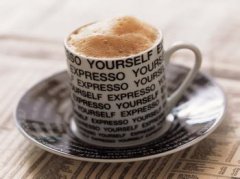The size of coffee powder depends on the way it is cooked.
When grinding beans, the size of the powder depends on the way it is cooked. Generally speaking, the shorter the cooking time, the finer the ground powder; the longer the cooking time, the thicker the ground powder. In terms of actual cooking, the ESPRESSO machine takes a very short time to make coffee, so the grinding is the finest, and the coffee powder is as fine as flour; it takes more than a minute to cook coffee in the "plug air" way, and the coffee powder is medium-sized grinding; American filter coffee takes a long time to make, so the coffee powder is the thickest, one by one like Beijing grains on a shell beach. Grinding coffee powder with the right thickness is very important for making a good cup of coffee, because the extraction of water-soluble substances in coffee powder has its ideal time, if the powder is very fine and cooked for a long time, resulting in excessive extraction, the coffee may be very bitter and lose its aroma. On the other hand, if the powder is coarse and cooked too fast, resulting in insufficient extraction, the coffee will be tasteless because it is too late to dissolve the water-soluble substance in the powder.
There are different brands and types of bean grinders for grinding coffee, and the ideal one is a grinder that can adjust the thickness of the beans. When grinding with a bean grinder, do not grind too much at one time, just enough powder for one time, because the longer the bean grinder is used at one time, the easier it is to get hot, which indirectly causes the coffee beans to be heated in the grinding process and causes the aroma to be released in advance, which will affect the aroma of the cooked coffee.
Coffee beans contain oil, so the bean grinder must be cleaned after grinding, otherwise the oil scale will be stale over a long period of time, and even the most advanced beans will be ground into strange-smelling powder. After each use of the bean grinder, be sure to wipe the blade table with the wet market and clean the plastic top cover with warm hot water. But for the American popular flavored coffee, the added flavor is strong and strong, and it will last for a long time. It is best to put two tablespoons of white Jing sugar in and beat it before cleaning. Of course, it is better for a grinder to grind only the same kind of beans, so there is no problem of mixing.

Important Notice :
前街咖啡 FrontStreet Coffee has moved to new addredd:
FrontStreet Coffee Address: 315,Donghua East Road,GuangZhou
Tel:020 38364473
- Prev

Coffee common sense some rules when drinking coffee
A good cup of coffee should be clear, bright and transparent. The concentration is different from turbidity. Generally speaking, the causes of turbidity are nothing more than the following: bad roasted coffee beans or powdered coffee beans are overbrewed for too long (the brewing temperature is too high and the brewing time is too fast) when you put the coffee spoon into the good coffee, the light of the coffee spoon will sparkle, and then scoop it up.
- Next

Coffee action coffee grounds help to remove toxic odor
There is good news for coffee lovers around the world: the large amount of coffee grounds they throw away helps remove the toxic smell of dirt. In the American Journal of Hazardous Materials, researchers at the City University of New York published a study saying that coffee grounds can absorb hydrogen sulfide gases, which are often caused by the fact that the dirt smells so bad. Now the common practice is to use activated carbon.
Related
- Beginners will see the "Coffee pull flower" guide!
- What is the difference between ice blog purified milk and ordinary milk coffee?
- Why is the Philippines the largest producer of crops in Liberia?
- For coffee extraction, should the fine powder be retained?
- How does extracted espresso fill pressed powder? How much strength does it take to press the powder?
- How to make jasmine cold extract coffee? Is the jasmine + latte good?
- Will this little toy really make the coffee taste better? How does Lily Drip affect coffee extraction?
- Will the action of slapping the filter cup also affect coffee extraction?
- What's the difference between powder-to-water ratio and powder-to-liquid ratio?
- What is the Ethiopian local species? What does it have to do with Heirloom native species?

